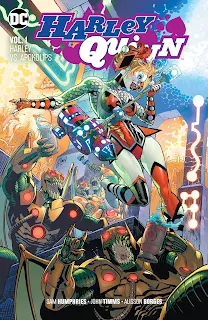[Review contains spoilers]
Overlapping a bit the last iteration of this title's dual finales by Amanda Conner and Jimmy Palmiotti and Frank Tieri respectively, Humphries' start sees Harley taking a vacation to get away from recent tragedies. That's interrupted, appropriately apropos of nothing, by Harley being kidnapped by and transformed into a Female Fury. At play here is Humphries taking Harley immediately out of the familiar and keeping her away for four issues, enough time for Humphries to hit a stride without the added presence of Harley's Brooklyn friends.
Simultaneously, Humphries gets to set Harley against the continuity-light backdrop of Apokolips that requires no major background knowledge, but that nonetheless lines up with Darkseid's absence as of Justice League Odyssey and etc. Thus, in a pretty typical "Harley clowns around for a while and then gets drawn in to playing hero" plot, Humphries has a lot working in his favor, and it's not a stretch to imagine this as a Harley vs. Apokolips standalone miniseries just the same as an arc in the main book. It helps considerably that series artist John Timms sticks around, so the changes are subtly in the dialogue and action and not directly in appearances.
In the adventure, Humphries introduces renegade Fury Petite Tina (or just the gargantuan "Tina"), who seems immediately perfect to join Harley's Brooklyn crew. But it's notable that Tina gets her own independent subplot in Humphries' second two-issue arc, when — in a story that involves Harley and her friends being evicted from their building — long-time characters like Big Tony only appear in the background from a distance. Again, probably the next volume will tell more of the tale, but I wouldn't be surprised if Humphries' run focuses on Harley and Tina to the absence of some of the others — that if Humphries makes the title his own by keeping some of Harley's locations and situations but laying over it his own cast. Which isn't outlandish, I don't think, and might indeed be a better way to separate the old from the new.
Seemingly the other character who most factors into these stories is Coach, the blind tech expert that uses a wheelchair whom Conner and Palmiotti introduced. I thought Coach was very effective as a zany Harley-verse gumshoe, especially in Harley Quinn and the Gang of Harleys. To that end, if Humphries intended his run to focus on Harley and Tina and Coach, I wouldn't be displeased with that, even if Humphries writes Coach a little "shoutier" than Conner and Palmiotti did.
Another aspect that newly distinguishes Humphries' run is the snippets of faux Harley comics he interjects. So far we've seen mainly two of these, vaguely in Dennis the Menace and Archie styles, and seemingly this all ties in to some continuity-hopping Jonni DC mess in the next book. But the parodies have so far been cute and well-drawn, even a bit more focused and less crazed than Conner and Palmiotti's dream sequences, and if these kept on throughout Humphries' run, I wouldn't mind.
Two issues by Christopher Sebela and Mirka Andolfo finish the book (even though they were released between Tieri's and Humphries' runs). This story ends better than it begins, with Harley making a comedic love connection between two cult members and facing off against Professor Pyg (more of those light continuity ties). The start of the story, however, has Harley seeing things and possibly having busted up her own favorite bodega without remembering it, and none of that is resolved satisfactorily. It gives the start a bit of dissonance that the story never recovers from. (Clearly the wiser move was to start the book with Humphries on Apokolips.)
Support Collected Editions -- Purchase Harley Quinn Vol. 1: Harley vs. Apokolips
So, one volume in to the "new" Harley Quinn with Harley Quinn Vol. 1: Harley vs. Apokolips, and it looks like we're on the right track. Sam Humphries finds a good middle of the road with one story where Harley frees Granny Goodness' Lowlies slaves and then another where Harley takes it upon herself to become assassin and off Lord Death Man in a variety of bloody ways. Which is to say, it remains to be seen if Humphries can ever recreate the amount of emotional complexity with which Amanda Conner and Jimmy Palmiotti imbued Harley Quinn, but at least he's showing her many sides, consistent with what came before.
[Includes original and variant covers]
Summary
Reviewer
Collected Editions
Review Date
Reviewed Item
Harley Quinn Vol. 1: Harley vs. Apokolips
Author Rating
3.75 (scale of 1 to 5)

Comments
To post a comment, you may need to temporarily allow "cross-site tracking" in your browser of choice.